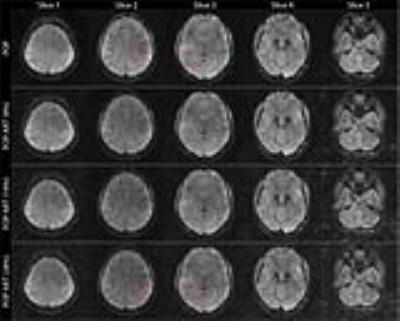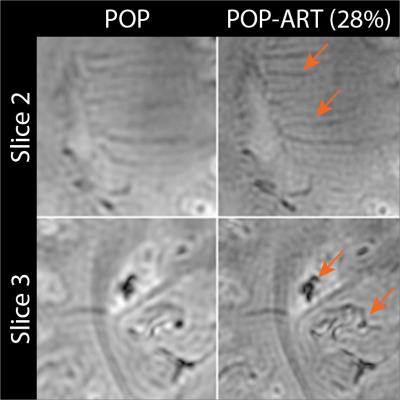5205
Resolution Enhancement in Ultra-High Field 3D Echo-Planar Imaging Using a Planes-on-a-Paddlewheel with Asymmetric Readout Train (POP-ART) Trajectory1The Centre for Advanced Imaging, The University of Queensland, Brisbane, Australia
Synopsis
3D planes-on-a-paddlewheel (POP) EPI is a non-Cartesian readout scheme realized by rotating EPI readout planes about the phase encoding axis. We show that the additional use of echo-asymmetry allows for significant improvements in spatial resolution without negative effects on echo-time, dropouts and distortions. The concept called POP-ART was evaluated at 7T. Whole brain images were obtained at a spatial resolution of 0.78x0.78x1.0mm3 within less than 1 minute by using an echo-asymmetry of only 28%. Being faster spoiled gradient-echo and providing resolutions not achievable by corresponding Cartesian EPI techniques, the trajectory is of interest for T2* weighted or quantitative susceptibility imaging.
Background
Susceptibility or T2* contrast based applications profit substantially from the increased contrast ultra-high field. This is in addition to the intrinsic signal-to-noise ratio advantage, which supports high spatial resolutions. To minimize the scan time in these high resolution applications, echo-planar imaging (EPI) is highly efficient (1). Major drawbacks are signal drop-outs and geometric distortions. Non-Cartesian 3D planes-on-a-paddlewheel (POP) EPI (2) was recently employed for whole-brain quantitative susceptibility mapping (QSM) at ultra-high field. The readout scheme is effective for echo time and distortion minimization and yielded images comparable to those of a corresponding 3D spoiled GRE acquisition.
In this work, we demonstrate how the use of echo-asymmetry within the non-Cartesian POP readout scheme (3) allows for significant improvements in spatial resolution without detrimental effects on echo-time, signal dropouts and geometric distortions.
Methods
In 3D POP EPI, a paddlewheel-shaped readout trajectory is created by rotating 2D EPI readout planes about the phase encoding axis (Fig. 1a, b and d) (2-4). After each excitation, a plane on this paddlewheel is sampled with the slab excitation typically performed along this rotation axis. Based on this readout scheme, an increase in spatial resolution can be achieved by introducing echo-asymmetry. As depicted in Fig. 1a, c and e, shifting the echo along the readout directly translates into higher spatial frequencies sampled during the acquisition. This creates undersampled areas in k-space, but does not change the acquisition time and has minimal impact on TE.
The concept called planes-on-a-paddlewheel with asymmetric readout train (POP-ART) was evaluated in a healthy volunteer (31, male) using a non-commercial 7 T whole-body research MRI scanner (Siemens Healthcare, Erlangen, Germany) under institutional review board permission. The system was equipped with a Tx/32 channel Rx head array (Nova Medical, USA). 3rd order shimming was employed for all measurements.
3D POP EPI images (2) were obtained at 1 mm isotropic spatial resolution using following acquisition parameters: FOV = 212 x 212 x 108 mm3, 360 projections, TR = 47 ms, TE = 24 ms, ES = 1.0 ms, flip angle = 13°, ramp sampling = 20%, 3-fold segmentation along phase encoding direction, acquisition time = 51 seconds. At the beginning of each readout train, 3 additional navigator echoes were acquired and an interleaved radial projection order was used to achieve a homogeneous azimuthal distribution of the planes (Fig. 1c). Additional scans with the same parameters and echo asymmetries of 9%, 19% and 28% were performed to achieve spatial resolutions of 0.9 x 0.9 x 1.0 mm3, 0.84 x 0.84 x 1.0 mm3, 0.78 x 0.78 x 1.0 mm3. As schematically depicted in Fig. 1e, the use of POP-ART entails undersampling of the higher spatial frequencies in k-space with undersampling factors of 2.0, 2.2 and 2.4.
Image reconstruction was performed offline using MATLAB (MathWorks, Natick, MA, USA). After combination of the segmentation subsets and phase correction, the individual readout planes were Fourier transformed along the phase encoding axis and gridded onto a Cartesian grid using the non-uniform fast Fourier transform (NUFFT) software (5). The ramp sampling interpolation was incorporated in the final gridding step.
Results
Representative results are shown in Fig. 2. The improvement in spatial resolution with increasing echo asymmetry (top to bottom) is clearly visible. The different POP-ART acquisitions provide similar image quality and, as expected, show similar behaviour in terms geometric distortions and signal dropouts. Some reconstruction artifacts are observed as low level high frequency streaking, as expected from the slight radial undersampling.
The clear resolution improvement is demonstrated in greater detail in Fig. 3, which depicts two enlarged sections of the brain (red boxes in Fig. 2) and compares the results between the conventional 3D POP scan and the 3D POP-ART acquisition with 28% echo asymmetry.
Discussion
High resolution 3D POP-ART EPI imaging was successfully performed at ultra-high field. Without echo time or acquisition time adjustments, an almost 2-fold improvement in spatial resolution was achieved with respect to conventional 3D POP EPI by using an echo-asymmetry of only 28%. The trajectory facilitates spatial resolutions that cannot be achieved with a corresponding Cartesian 3D EPI protocol. With acquisition times on the order of 1 minute, the proposed approach is considerably faster than a corresponding standard Cartesian 3D GRE protocol.
The radial nature of the POP-ART readout scheme is beneficial in terms of motion robustness and provides high flexibility for undersampling. The concept is of interest for high resolution for T2* weighted imaging or quantitative susceptibility mapping of the brain. Future work will target these applications and evaluate the limits in terms of resolution enhancement.
Acknowledgements
MB acknowledges funding from ARC Future Fellowship grant FT140100865. The authors acknowledge the facilities of the National Imaging Facility at the Centre for Advanced Imaging, University of Queensland.References
1. Mansfield P, J Phys C Solid State Phys 1977;10:L55.
2. Stäb D, NMR Biomed 2016;
DOI: 10.1002/nbm.3620.
3. Jonathan SV, Magn Reson
Med 2014;71:2127–2138.
4. McNab JA, Magn Reson Med 2010: 235–242.
5. Fessler JA, IEEE Trans. Signal Process.
2003;51:560–574.
Figures


